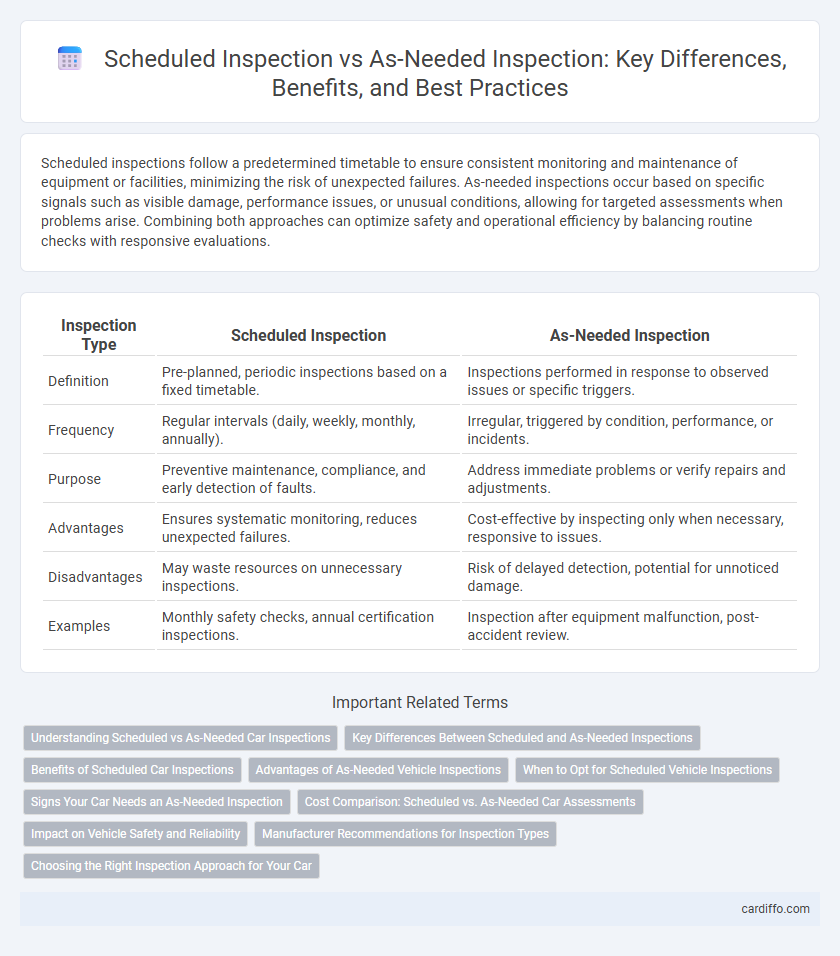Scheduled inspections follow a predetermined timetable to ensure consistent monitoring and maintenance of equipment or facilities, minimizing the risk of unexpected failures. As-needed inspections occur based on specific signals such as visible damage, performance issues, or unusual conditions, allowing for targeted assessments when problems arise. Combining both approaches can optimize safety and operational efficiency by balancing routine checks with responsive evaluations.
Table of Comparison
| Inspection Type | Scheduled Inspection | As-Needed Inspection |
|---|---|---|
| Definition | Pre-planned, periodic inspections based on a fixed timetable. | Inspections performed in response to observed issues or specific triggers. |
| Frequency | Regular intervals (daily, weekly, monthly, annually). | Irregular, triggered by condition, performance, or incidents. |
| Purpose | Preventive maintenance, compliance, and early detection of faults. | Address immediate problems or verify repairs and adjustments. |
| Advantages | Ensures systematic monitoring, reduces unexpected failures. | Cost-effective by inspecting only when necessary, responsive to issues. |
| Disadvantages | May waste resources on unnecessary inspections. | Risk of delayed detection, potential for unnoticed damage. |
| Examples | Monthly safety checks, annual certification inspections. | Inspection after equipment malfunction, post-accident review. |
Understanding Scheduled vs As-Needed Car Inspections
Scheduled car inspections follow manufacturer-recommended intervals to ensure vehicle safety, performance, and compliance with regulations, typically occurring every 6 to 12 months or based on mileage. As-needed inspections are performed when symptoms or issues arise, such as warning lights, unusual noises, or after accidents, addressing immediate problems before they escalate. Understanding the benefits and limitations of both approaches helps maintain optimal vehicle condition and prevent costly repairs.
Key Differences Between Scheduled and As-Needed Inspections
Scheduled inspections follow a predefined timetable, ensuring regular assessment of equipment or infrastructure to prevent failures and maintain compliance with safety standards. As-needed inspections occur based on observed signs of wear, damage, or operational anomalies, addressing issues reactively to prevent further deterioration or hazards. The key difference lies in the proactive nature of scheduled inspections versus the reactive approach of as-needed inspections, impacting maintenance strategies and risk management.
Benefits of Scheduled Car Inspections
Scheduled car inspections ensure timely detection of potential issues, enhancing vehicle safety and reliability by adhering to manufacturer-recommended maintenance intervals. Regularly planned inspections reduce the risk of costly repairs and breakdowns by addressing wear and tear before they escalate. Maintaining a consistent inspection schedule also preserves vehicle resale value and complies with regulatory requirements.
Advantages of As-Needed Vehicle Inspections
As-needed vehicle inspections offer flexibility by allowing maintenance to be performed based on actual vehicle condition, reducing unnecessary service costs. These inspections help identify specific issues early, preventing extensive damage and improving overall vehicle reliability. Focusing on real-time vehicle performance enhances safety and ensures resources are allocated efficiently.
When to Opt for Scheduled Vehicle Inspections
Scheduled vehicle inspections are essential for ensuring safety compliance and identifying potential mechanical issues before they escalate, particularly for commercial fleets subject to regulatory mandates. Opting for scheduled inspections is advisable when adhering to warranty requirements or maintaining consistent vehicle performance over time. Regular inspection intervals reduce unexpected breakdowns and enhance long-term cost savings by addressing wear and tear proactively.
Signs Your Car Needs an As-Needed Inspection
Signs your car needs an as-needed inspection include unusual engine noises, dashboard warning lights, and decreased fuel efficiency. These indicators suggest potential mechanical issues that require immediate attention beyond scheduled maintenance. Addressing problems promptly through as-needed inspections can prevent costly repairs and ensure vehicle safety.
Cost Comparison: Scheduled vs. As-Needed Car Assessments
Scheduled car inspections typically incur higher upfront costs due to regular maintenance and comprehensive diagnostics, which can prevent costly repairs by identifying issues early. As-needed inspections often result in lower immediate expenses but may lead to higher long-term costs if undetected problems escalate into major repairs. Comparing total expenditures, scheduled inspections generally offer better cost efficiency by minimizing risk and extending vehicle lifespan through proactive care.
Impact on Vehicle Safety and Reliability
Scheduled inspections follow a fixed timeline based on mileage or time intervals, ensuring regular checks that prevent unexpected vehicle failures and enhance overall safety and reliability. As-needed inspections rely on driver observations or symptom occurrence, which may delay issue detection and increase the risk of breakdowns or safety hazards. Consistent scheduled inspections significantly reduce maintenance costs and extend vehicle lifespan by identifying potential problems before they escalate.
Manufacturer Recommendations for Inspection Types
Manufacturer recommendations for inspection types distinguish between scheduled inspections, performed at regular, predefined intervals, and as-needed inspections, triggered by specific signs of wear, damage, or performance issues. Scheduled inspections adhere to manufacturer-defined timelines to ensure consistent monitoring and maintain warranty compliance, while as-needed inspections address immediate concerns based on operational conditions or anomalies. Both inspection types play critical roles in extending equipment lifespan and preventing unexpected failures by aligning maintenance activities with manufacturer guidelines.
Choosing the Right Inspection Approach for Your Car
Scheduled inspections ensure timely detection of potential issues by following manufacturer-recommended intervals, enhancing vehicle safety and performance. As-needed inspections provide flexibility, addressing problems when symptoms arise or after specific events like accidents or unusual noises. Selecting the right approach depends on factors such as vehicle age, usage patterns, and maintenance history to optimize reliability and cost-efficiency.
Scheduled inspection vs as-needed inspection Infographic

 cardiffo.com
cardiffo.com